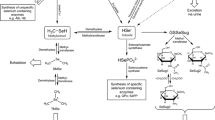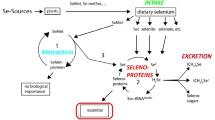Abstract
The diets of 5 patients with phenylketonuria or maple-syrup-urine disease were supplemented with yeast which was rich in selenium. For 120 days the patients received 45 μg Se/day to increase the Se content of their diets to 10–12ng Se/Kjoule. Before supplementation the selenium content of serum (5–15 ng/ml) and whole blood (10–27 ng/ml), and the activity of the erythrocyte glutathione peroxidase (0.19–2.69 U37/g Hb), amounted to only 10–20% of normal. The serum selenium content reached normal values within 4 weeks of supplementation, followed by normalisation of the selenium content of whole blood within 4–8 weeks. Restoration of the activity of erythrocyte glutathione peroxidase took 9 to 15 weeks —the red cell life span. There was a significant positive correlation between the selenium content of the erythrocytes and the activity of erythrocyte glutathione peroxidase.
Similar content being viewed by others
References
Burk, R. F., Pearson, W. N., Wood, R. P., Viteri, F.: Blood selenium levels and in vitro red blood cell uptake of 75-Se in Kwashiorkor. Amer. J. Clin. Nutr. 20, 723–733 (1967)
Cross, J. D., Raie, R. M., Smith, H., Smith, L. B.: Dietary selenium in the Glasgow area. Radiochem. Radioanal. Lett. 35, 281–290 (1978)
Diplock, A. T., Coker, O. E.: The effect of cadmium in the uptake and distribution of selenium in tissues of normal and vitamin E deficient rats. 3rd International Symposium on Selenium and Tellurium Chemistry, July 1979, Metz
Günzler, W. A., Kremers, H., Flohé, L.: An improved coupled test procedure for glutathione peroxidase in blood. Z. Klin. Chem. Klin. Biochem. 12, 444–448 (1974)
Kasperek, K.: Analytical techniques for the determination of 20 trace elements in biological samples by means of instrumental thermal neutron activation analysis. In: Proc. of the 2nd Internat. Conf. on Nuclear Methods in Environmental Research. U.S. Energy Research and Development Administration, Conf. 740, 701 (1974)
Lawrence, R. A., Burk, R. F.: Glutathione peroxidase activity in selenium-deficient rat liver. Biochem. Biophys. Res. Commun. 71, 952–958 (1976)
Levander, O. A.: Factors that modify the toxicity of selenium. In: Newer trace elements in nutrition, Vol. 5, W. Mertz, W. E. Cornatzer (eds.), p. 57. New York: Marcel Dekker Inc. 1971
Levine, R. J., Olson, R. E.: Blood selenium in Thai children with protein-caloric malnutrition. Proc. Soc. Exp. Biol. Med. 134, 1030–1034 (1970)
Lombeck, I., Kasperek, K., Harbisch, H. D., Feinendegen, L. E., Bremer, H. J.: The selenium state of healthy children. I. Serum selenium concentration at different ages; activity of glutathione peroxidase of erythrocytes at different ages; selenium content of food of infants. Eur. J. Pediatr. 125, 81–88 (1977)
Lombeck, I., Kasperek, K., Harbisch, H. D., Becker, K., Schuman, E., Schröter, W., Feinendegen, L. E., Bremer, H. J.: The selenium state of children. II. Selenium content of serum, whole blood, hair and the activity of erythrocyte glutathione peroxidase in dietetically treated patients with phenylketonuria and maple-syrup-urine disease. Eur. J. Pediatr. 128, 213–223 (1978)
Perona, G., Cellerino, R., Guidi, G. C., Moschini, G., Stievano, B. M., Tregnaghi, C.: Erythrocytic glutathione peroxidase: Its relationship to plasma selenium in man. Scand. J. Haematol. 19, 116–120 (1977)
Paglia, D. E., Valentine, W. N.: Studies on the quantitative and qualitative characterization of erythrocyte glutathione peroxidase. J. Lab. Clin. Med. 158–169 (1967)
Robinson, M. F., Rea, H. M., Friend, G. M., Stewart, R. D. H., Snow, P. C., Thomson, C. D.: On supplementing the selenium intake of New Zealanders. 2. Prolonged metabolic experiments with daily supplements of selenomethionine, selenite and fish. Br. J. Nutr. 39, 589–600 (1978)
Sakurai, H., Tsuchiya, A.: A tentative recommendation for the maximum daily intake of selenium. Environ. Physiol. Biochem. 5, 107–118 (1975)
Schrautzer, G. N.: Selenium and cancer. Chem. Scripta 8A, 108 (1975)
Schroeder, H. A., Frost, D. V., Balassa, J. J.: Essential trace metals in man: Selenium. J. Chron. Dis. 23, 227–243 (1970)
Schwarz, K.: Selenium and Kwashiorkor. Lancet 1965 I, 1335–1336
Thompson, J. N., Erdy, P., Smith, D. C.: Selenium content of food consumed by Canadians. J. Nutr. 105, 274–277 (1975)
Thomson, C. D., Rea, H. M., Doesburg, V. M., Robinson, M. F.: Selenium concentration and glutathione peroxidase activities in whole blood of New Zealand residents. Br. J. Nutr. 37, 457–460 (1977)
Thomson, C. D., Burton, C. E., Robinson, M. F.: On supplementing the selenium intake of New Zealanders. I. Short experiments with large doses of selenite or selenomethionine. Br. J. Nutr. 39, 579–587 (1978)
Thorn, J., Robertson, J., Buss, D. H., Bunton, N. G.: Trace nutritions. Selenium in British food. Br. J. Nutr. 39, 391–396 (1978)
Watkinson, J. H.: The selenium status of New Zealanders. N. Z. Med. J. 523, 202–205 (1974)
Westermark, T., Sandholm, M.: Decreased erythrocyte glutathione peroxidase activity in neuronal ceroid lipofuscinosis (NCL)—corrected with selenium supplementation. Acta Pharmacol. Toxicol. 40, 70–74 (1977)
Wikström, J., Westermarck, T., Palo, J.: Selenium, vitamin E and copper in multiple sclerosis. Acta Neurol. Scand. 54, 287–290 (1976)
Author information
Authors and Affiliations
Additional information
With support of Deutsche Forschungsgemeinschaft
Rights and permissions
About this article
Cite this article
Lombeck, I., Kasperek, K., Bachmann, D. et al. Selenium requirements in patients with inborn errors of amino acid metabolism and selenium deficiency. Eur J Pediatr 134, 65–68 (1980). https://doi.org/10.1007/BF00442405
Received:
Issue Date:
DOI: https://doi.org/10.1007/BF00442405




